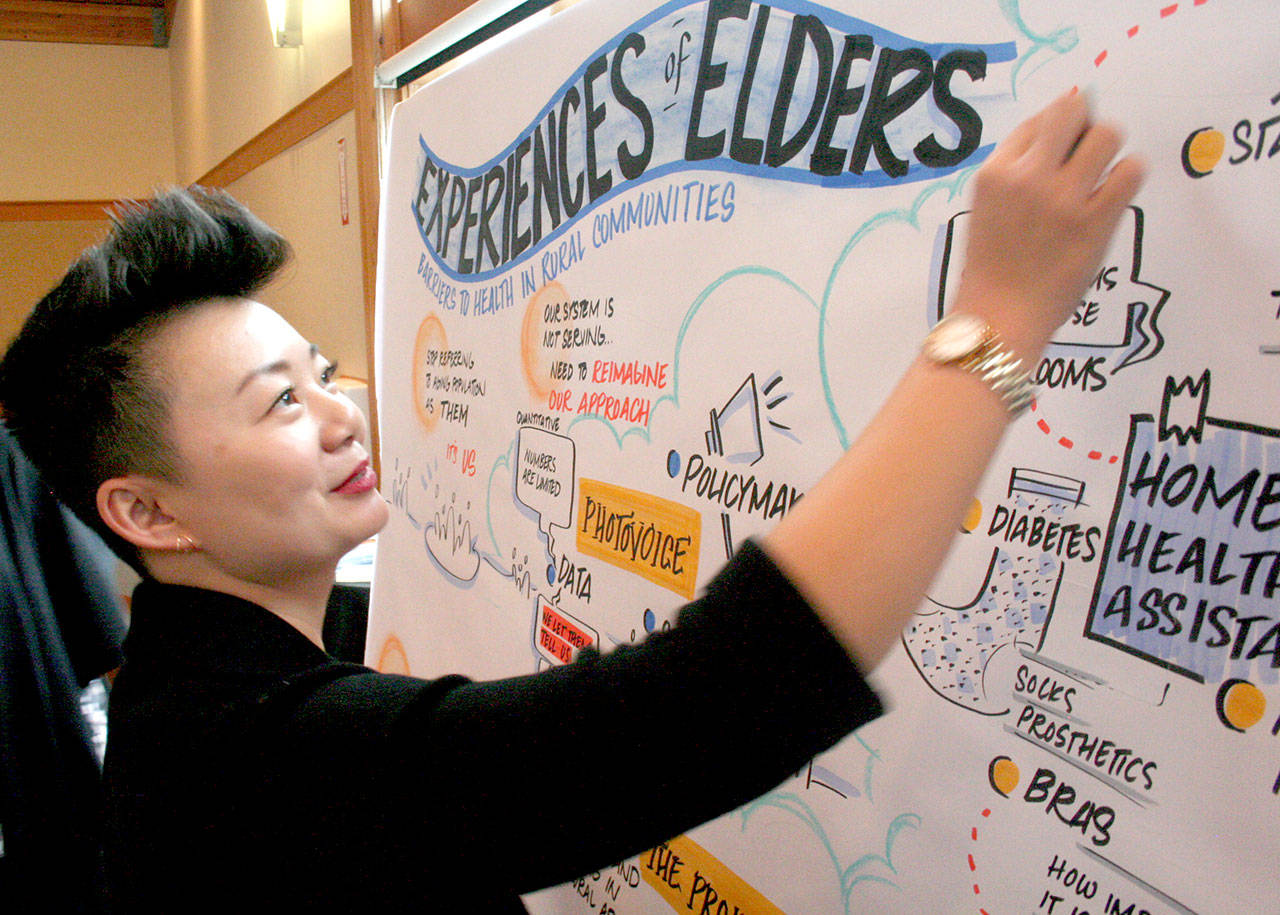PORT TOWNSEND — An elderly woman suddenly found herself in an unfamiliar situation. Her husband of six decades had died, and all of her family members lived out of the state.
Suddenly, she was living alone and there were many things she couldn’t do by herself.
Her husband had always changed the thermostat.
She couldn’t carry in groceries. Her mobility was limited.
She called 9-1-1.
During a two-month period, the woman accessed the emergency system 17 times for non-medical purposes.
She’s not alone.
“We see a lot of people who are vulnerable and alone,” East Jefferson Fire-Rescue Chief Jim Walkowski said.
The North Olympic Peninsula is getting older, particularly in rural areas, and the use of the 9-1-1 system has an increasing trend of responding to non-emergency calls for a variety of reasons.
Regional health care workers shared some of their strategies Monday during a daylong conference hosted by Jefferson Healthcare at the Northwest Maritime Center in Port Townsend.
It was one of just three sites selected nationwide by the National Center for Complex Health and Social Needs, an initiative of the Camden Coalition of Healthcare Providers on the health of older adults in rural communities.
About 120 people attended, mostly from Western Washington, with representatives from Jefferson, Clallam, Mason, Island and Grays Harbor counties.
Walkowski told the story about the elderly woman who needed help and said most of his department’s contacts with patients are with those who are 50 and older.
“We see this increasing every single year,” he said.
One-third of Jefferson County’s 30,524 people in 2017 were 65 and older with a median age of 57.1, according to U.S. Census statistics. Clallam County was not far behind with 27.4 percent of its 73,439 people in 2017 being age 65 or older with a median of 50.5.
That’s translating to a higher rate of calls to connect patients to social services, Walkowski said.
One of the main goals is to provide that access to people before they call 9-1-1, and Walkowski wants to do that by implementing community risk-reduction programs.
Clallam County has implemented a community paramedicine program this year with Daniel Montana, a firefighter/paramedic for the Port Angeles Fire Department.
Montana has built his own program based on referrals from social workers, doctors and firefighter/paramedics who respond to non-medical 9-1-1 calls.
He calls it an emergency medical services prevention program that aims to learn about the needs for the super-users of the 9-1-1 system and to be able to take care of them before they call for help.
The types of people Montana has helped include the homeless, those who have substance-abuse or mental-health conditions, those with chronic medical conditions or older adults who have other needs, he said.
“What makes it effective is we take it to the people,” Montana said.
“My assessments as a paramedic used to be all about the body,” he said. “Now it’s my lead-in. We’re talking about the mind, body and soul. If you’re having trouble with one, it’s bound to affect the other two.”
Joey Rodrigues, the director of Olympic Ambulance in Sequim, said 68 percent of the people in his service territory who have accessed the 9-1-1 system are 65 and older. A little more than half end up in a hospital emergency department, but 44 percent are not transported because they don’t have an underlying medical issue.
Rodrigues said he’s worked with a fall-prevention program and helped patients with everything from grab bars in their showers to a taller toilet seat.
He also told the story of a man who walked a mile and a half down his driveway to get his mail for 50 years.
“He wasn’t about to change that routine for anything,” Rodrigues said.
Then the man started to fall on his walk, and he would call 9-1-1 for help.
Rodrigues said he worked with the U.S. Postal Service to have the man’s mail delivered directly to his front door.
“A lot of times, it’s asking people with their first encounter and engaging with them to assess their needs before they continue to access the 9-1-1 call center,” he said.
Underlying patterns of use sometimes deal with mobility issues but also a lack of education about available community resources, Montana said.
Rodrigues said he sees patients with Alzheimer’s, dementia or an undiagnosed memory-loss condition. Sometimes meeting with them for an hour every other week or having a dispatcher engage with them in a 10-minute phone call can help, he said.
General stress and anxiety are factors, as well as a loss of independence, support networks or family assistance, Montana said.
“People are living longer, and their spouse passes away, and sometimes all their friends have passed away,” he said. “They’ve done a great job with raising their kids, but their kids are off being adults with their own families. The last thing they want to do is call them for help.”
One of the best tools of intervention can come within a few days of when someone is released from a hospital. Health care providers can help manage where medications are located and where other high-use items are stored within a patient’s living space, he said.
“When they call 9-1-1, it’s immediate gratification to get the help they need, but it’s not the complete circle,” Montana said.
Conference attendees also heard from Dr. Anna Tresidder of Spokane. Her keynote address covered experiences from 10 senior citizens who faced barriers to health care in their rural Eastern Washington communities.
Breakout sessions focused on adding arts to seniors’ everyday living, how to engage across communities and organizations, and aging in a healthy way.
The conference included a worksheet that would encourage attendees to list ways in which they can better engage with their aging populations with action items that will be reviewed in a few months.
________
Jefferson County Managing Editor Brian McLean can be reached at 360-385-2335, ext. 6, or at bmclean@peninsuladailynews.com.

